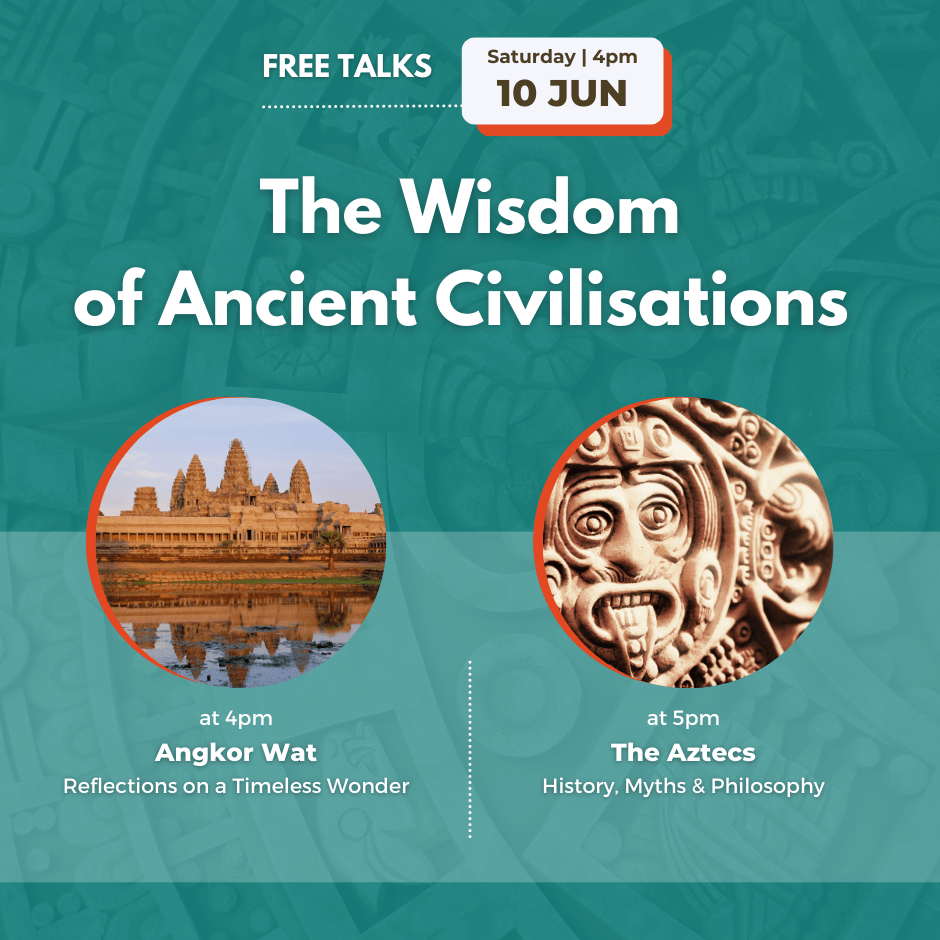Angkor Wat – Reflections on a Timeless Wonder | 4pm
Built during the height of the Khmer Empire in Cambodia, Angkor Wat is a testament to the ingenuity, creativity, and spiritual connection of the Khmer people.
The iconic temple city of Angkor has always inspired and intrigued our imagination. With its rich imagery and symbolism from Buddhism and Hinduism, such as the Bhagavad Gita, as well as through the architecture of the temple itself it serves as a timeless reminder of the path of the human spirit.
Come on a philosophical journey through this marvel of Cambodian and human history.
The Aztecs – History, Myths & Philosophy | 5pm
When the conquistadors first discovered the Aztecs in the 16th century they were amazed at what they discovered, their beautiful city on a lake, their architecture, canals, markets, great craftsmanship, but they were also curious how they lived, what was their vision of life.
In this talk we are going to explore this through the lens of Aztec mythology and philosophy that will allow us to unveil a deeper understanding and meaning to the Aztec world.
Join us as we journey through the history, symbolism and other dimensions of these civilisations to discover keys to apply in our daily lives.
Some historical information on Angkor Wat and the Aztecs:
Angkor Wat
There are many mysteries and superlatives surrounding the magnificent temple – Angkor Wat.
It is enormous, quadruple in size of Vatican City and was often mistaken as a city. It is one of the 7 wonders of the world and the largest religious site in the world.
It is not only a architectural marvel but contains also highly symbolic elements, representing the full cycle of existence, scenes of daily life, heroic battles and is also, according to legend, the symbolic home of the god Vishnu.
The Aztecs
“In Nahuatl, the language of the Aztec world, one key word for poet was ‘tlamatine’ meaning ‘the one who knows’ or ‘he who knows something’. Poets were considered ‘sages of the word’, who meditated on human enigmas and explored the beyond, the realm of the gods” – Edward Hirsch
In the native language of Nahuatl, “White Land” means Atzlan, or perhaps the name originated in myth, according to Aztec mythology, their people emerged from a legendary land called Aztlán, which later developed into the Aztecs. However, they referred to themselves as Mexica.
Originated likely as a nomadic, hunters and gatherers tribe from northern Mexico, they arrived around the 13th century in Mesoamerica.
Tenochtitlan was their legendary capital until 1521 when the Spanish conquistador Hernán Cortés sacked and conquered this magnificent city.
Similar to many prominent cities there was a legend surrounding the beginning of their settlement, the mysterious city Tenochtitlan. It was founded on advice of their patron god Huitzilopochtli, who told them to establish the city at a place where they find a giant eagle eating a snake perched on a cactus.
The eagle represents in many mythologies the bird of the gods as it can reach the highest points, the snake represents transformation, cycles, regeneration and a cactus often represents resilience, protection, endurance and survival.
